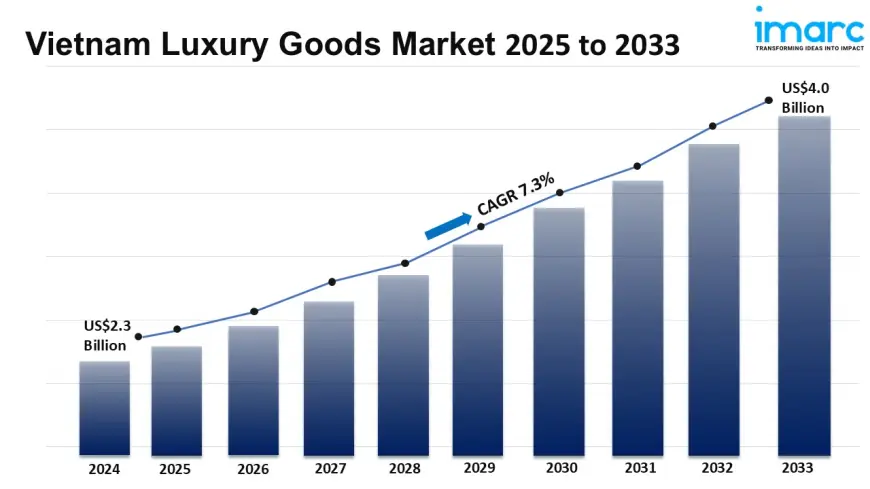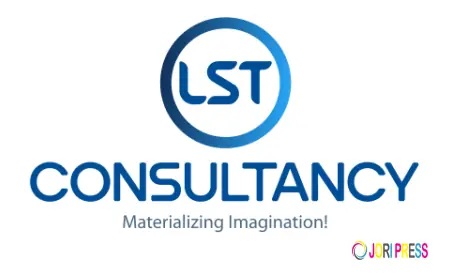Vietnam Luxury Goods Market Size, Share, Top Companies, Forecast 2025-2033
The Vietnam luxury goods market size reached USD 2.3 Billion in 2024. Looking forward, IMARC Group expects the market to reach USD 4.0 Billion by 2033, exhibiting a growth rate (CAGR) of 7.3% during 2025-2033.

According to the latest report by IMARC Group, titled “Vietnam Luxury Goods Market Report by Product Type (Watches and Jewellery, Perfumes and Cosmetics, Clothing, Bags/Purse, and Others), Distribution Channel (Offline, Online), End User (Women, Men), and Region 2025-2033”, offers a comprehensive analysis of the industry, which comprises insights on the Vietnam luxury goods market. The report also includes competitor and regional analysis, and contemporary advancements in the global market.
The Vietnam luxury goods market size reached USD 2.3 Billion in 2024. Looking forward, IMARC Group expects the market to reach USD 4.0 Billion by 2033, exhibiting a growth rate (CAGR) of 7.3% during 2025-2033. The rising disposable income among individuals, the significant expansion in the tours and travel industry, and the growing e-commerce and online platforms offering customers to explore several luxury products represent some of the key factors driving the market.
Request Free Sample Report: https://www.imarcgroup.com/vietnam-luxury-goods-market/requestsample
Vietnam Luxury Goods Market Dynamics:
Surging Affluent Demographics & Evolving Consumer Profile
Vietnam's luxury market growth is fundamentally propelled by a rapidly expanding base of high-net-worth individuals (HNWIs) and an increasingly influential younger generation. Wealth creation, driven by a robust economy, flourishing private sector, and significant foreign investment, is concentrating disposable income among a growing elite. Crucially, the consumer profile is evolving beyond the traditional ultra-wealthy segment. Aspirational upper-middle-class consumers, particularly digitally-native Millennials and Gen Z, are emerging as powerful drivers. This cohort exhibits distinct preferences: they are highly brand-conscious, deeply research purchases online via social media and review platforms, and prioritize experiences alongside product ownership. Their values increasingly encompass sustainability, ethical sourcing, and brand authenticity. Luxury brands must therefore navigate a dual challenge: catering to the established HNWIs demanding exclusivity and heritage, while simultaneously engaging younger consumers through digital innovation, personalized experiences, and compelling brand narratives that resonate with their social consciousness and desire for self-expression. This demographic shift necessitates sophisticated segmentation, multi-channel engagement strategies, and a nuanced understanding of the diverse motivations across Vietnam's luxury consumer spectrum to capture sustained growth potential.
Digital Transformation & Omnichannel Experience Imperative
The digital revolution is fundamentally reshaping luxury retail in Vietnam, accelerating beyond initial e-commerce adoption to a pervasive omnichannel reality. While physical boutiques in premier locations like Hanoi and Ho Chi Minh City remain vital for brand image and tactile experiences, online channels are indispensable for discovery, research, and increasingly, conversion. Social commerce, particularly via visually-driven platforms like Instagram, TikTok, and Facebook, is a primary discovery engine, heavily influencing purchase decisions, especially among younger consumers. Brands are investing significantly in sophisticated e-commerce platforms, seamless mobile experiences, and leveraging digital marketing – including collaborations with Key Opinion Leaders (KOLs) and micro-influencers who command high trust. The future demand hinges on seamlessly integrating these digital touchpoints with physical retail. Consumers expect services like click-and-collect, virtual consultations, exclusive online drops, and in-store tech enhancements (AR try-ons, digital lookbooks). Success requires creating a frictionless, personalized journey where online research smoothly transitions to offline purchase (or vice-versa), supported by robust CRM systems and data analytics to understand and anticipate individual preferences across the entire customer lifecycle.
Infrastructure Maturation & Retail Landscape Evolution
The physical foundation for luxury retail growth is solidifying through significant infrastructure development and the evolution of premium retail spaces. Major cities, especially Ho Chi Minh City and Hanoi, are witnessing the completion of world-class mixed-use developments and luxury shopping malls designed specifically to attract high-end brands (e.g., The Grand Ho Tram Strip complex, new phases of Vincom Center, Takashimaya). International hospitality groups are expanding their luxury and ultra-luxury hotel footprints, creating natural adjacencies for retail. Furthermore, improvements in international air connectivity and tourism infrastructure are facilitating easier access for both international luxury tourists and domestic consumers traveling abroad, exposing them to global trends and brands. This infrastructure boom elevates Vietnam's positioning on the global luxury map, attracting more brands to establish flagship stores or enter the market for the first time. The evolving retail landscape intensifies competition, pushing brands beyond mere presence to offer exceptional in-store experiences, highly trained staff, and exclusive services. Future demand will be concentrated in these premium destinations, but also driven by the convenience and experience they offer, making the quality and location of physical retail a critical strategic consideration for sustained market penetration and growth.
Competitive Landscape:
The competitive landscape of the industry has also been examined along with the profiles of the key players.
Vietnam Luxury Goods Market Trends
The Vietnamese luxury landscape is poised for a significant evolutionary leap, characterized by a deepening sophistication in consumer expectations and brand strategies. Experiential luxury will transcend mere product acquisition, becoming the paramount differentiator. Consumers will increasingly seek immersive brand engagements – exclusive events, personalized services, art collaborations, and bespoke offerings that forge emotional connections and convey unique status. This shift necessitates brands moving beyond transactional relationships to cultivate communities and craft narratives that resonate deeply with local cultural nuances while maintaining global allure. Concurrently, personalization will scale beyond monogramming, leveraging data analytics and AI to offer hyper-relevant product recommendations, curated content, and truly individualized services, both online and in-store. Sustainability and ethical considerations, evolving from niche concerns to core purchase drivers, will demand demonstrable action. Transparency across the supply chain, tangible commitments to environmental stewardship, and authentic social responsibility initiatives will be non-negotiable for brand credibility, particularly among younger, values-driven consumers. Digital integration will mature further, with augmented reality (AR) for virtual try-ons and immersive storytelling, seamless omnichannel journeys, and potentially exploring Web3 applications like NFTs for exclusive access or digital collectibles, though physical boutiques will remain crucial as experiential sanctuaries. Success hinges on a delicate balance: embracing cutting-edge digital engagement while delivering unparalleled, human-centric physical experiences, all underpinned by genuine sustainability and a profound understanding of the Vietnamese consumer's evolving desire for meaning, exclusivity, and authentic brand alignment.
Ask Our Expert & Browse Full Report with TOC & List of Figure: https://www.imarcgroup.com/request?type=report&id=19772&flag=C
Vietnam Luxury Goods Market Industry Segmentation:
Product Type Insights:
- Watches and Jewellery
- Perfumes and Cosmetics
- Clothing
- Bags/Purse
- Others
Distribution Channel Insights:
- Offline
- Online
End User Insights:
- Women
- Men
Regional Insights:
- Northern Vietnam
- Central Vietnam
- Southern Vietnam
Key highlights of the Report:
- Market Performance
- Market Outlook
- COVID-19 Impact on the Market
- Porter’s Five Forces Analysis
- Historical, Current and Future Market Trends
- Market Drivers and Success Factors
- SWOT Analysis
- Structure of the Market
- Value Chain Analysis
- Comprehensive Mapping of the Competitive Landscape
Note: If you need specific information that is not currently within the scope of the report, we can provide it to you as a part of the customization.
About Us
IMARC Group is a leading market research company that offers management strategy and market research worldwide. We partner with clients in all sectors and regions to identify their highest-value opportunities, address their most critical challenges, and transform their businesses.
IMARC’s information products include major market, scientific, economic and technological developments for business leaders in pharmaceutical, industrial, and high technology organizations. Market forecasts and industry analysis for biotechnology, advanced materials, pharmaceuticals, food and beverage, travel and tourism, nanotechnology and novel processing methods are at the top of the company’s expertise.
Contact US:
IMARC Group
134 N 4th St. Brooklyn, NY 11249, USA
Email: [email protected]
Tel No:(D) +91 120 433 0800
United States: +1-631-791-1145
What's Your Reaction?
 Like
0
Like
0
 Dislike
0
Dislike
0
 Love
0
Love
0
 Funny
0
Funny
0
 Angry
0
Angry
0
 Sad
0
Sad
0
 Wow
0
Wow
0
















































